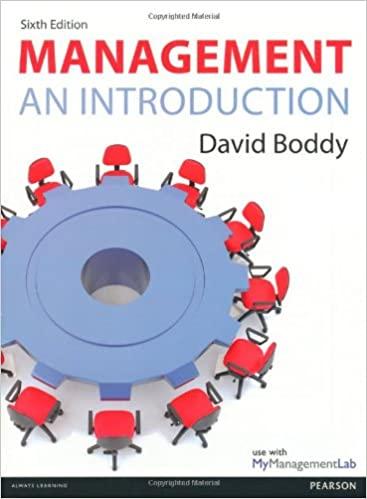Answered step by step
Verified Expert Solution
Question
1 Approved Answer
1. Which of the following is a similarity between goods and services? a. Both can be standardized for the mass market or customized to individual
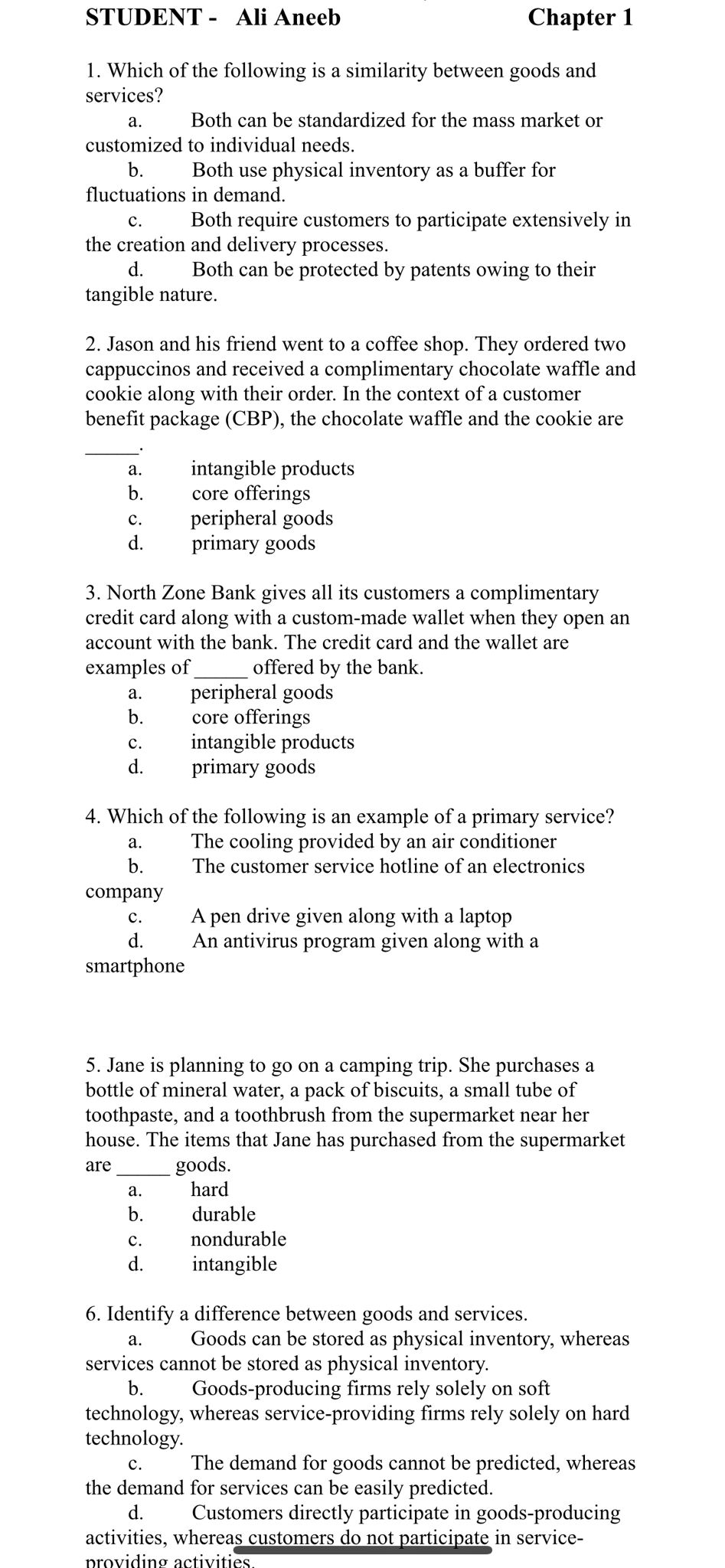
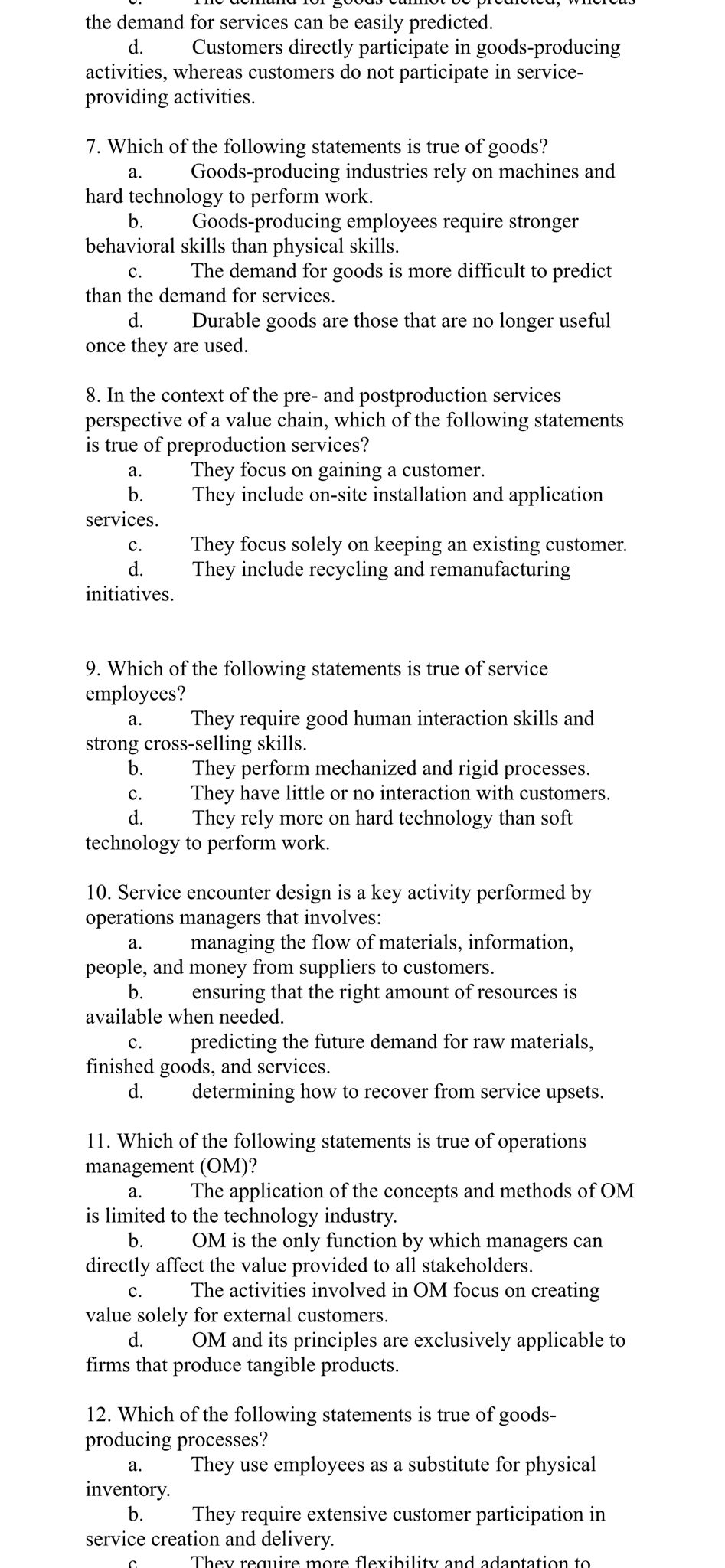
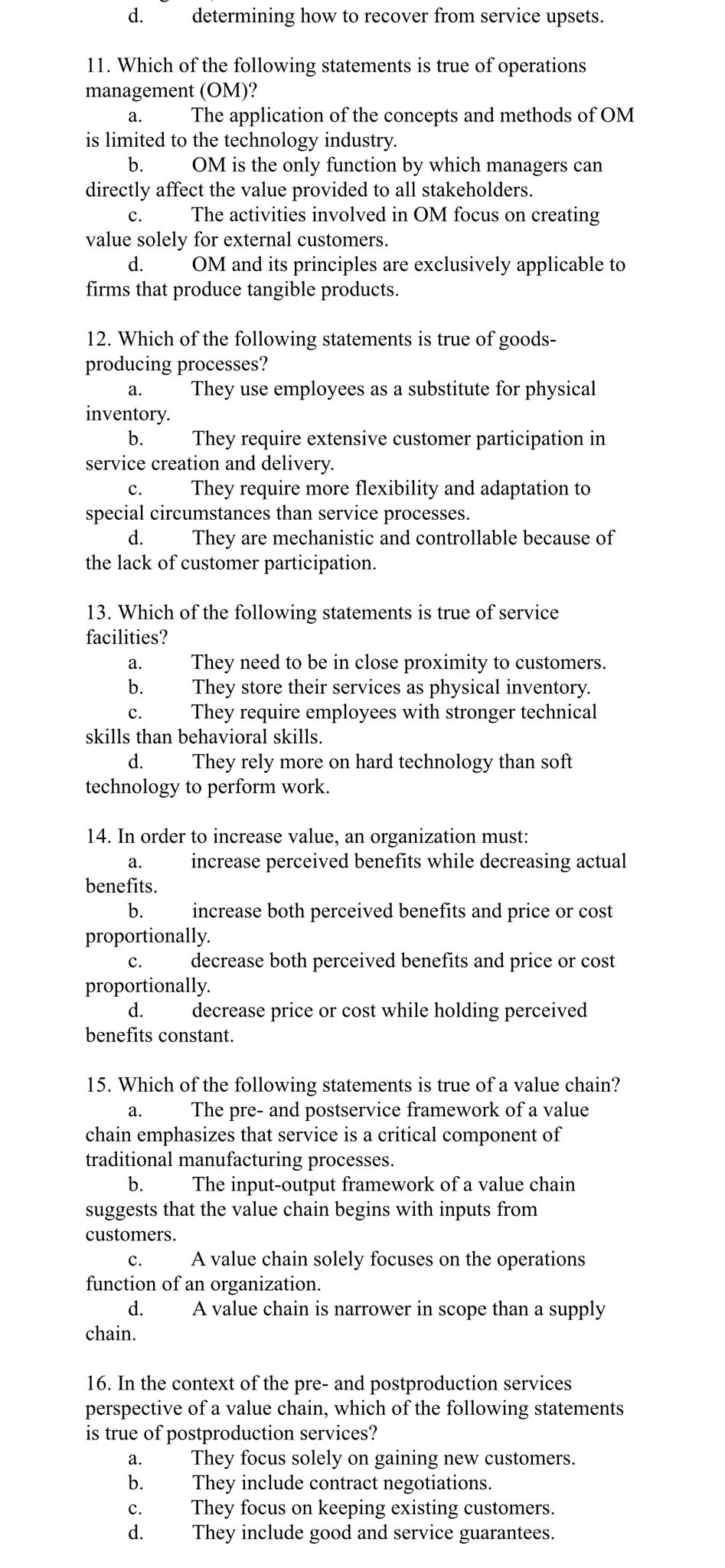
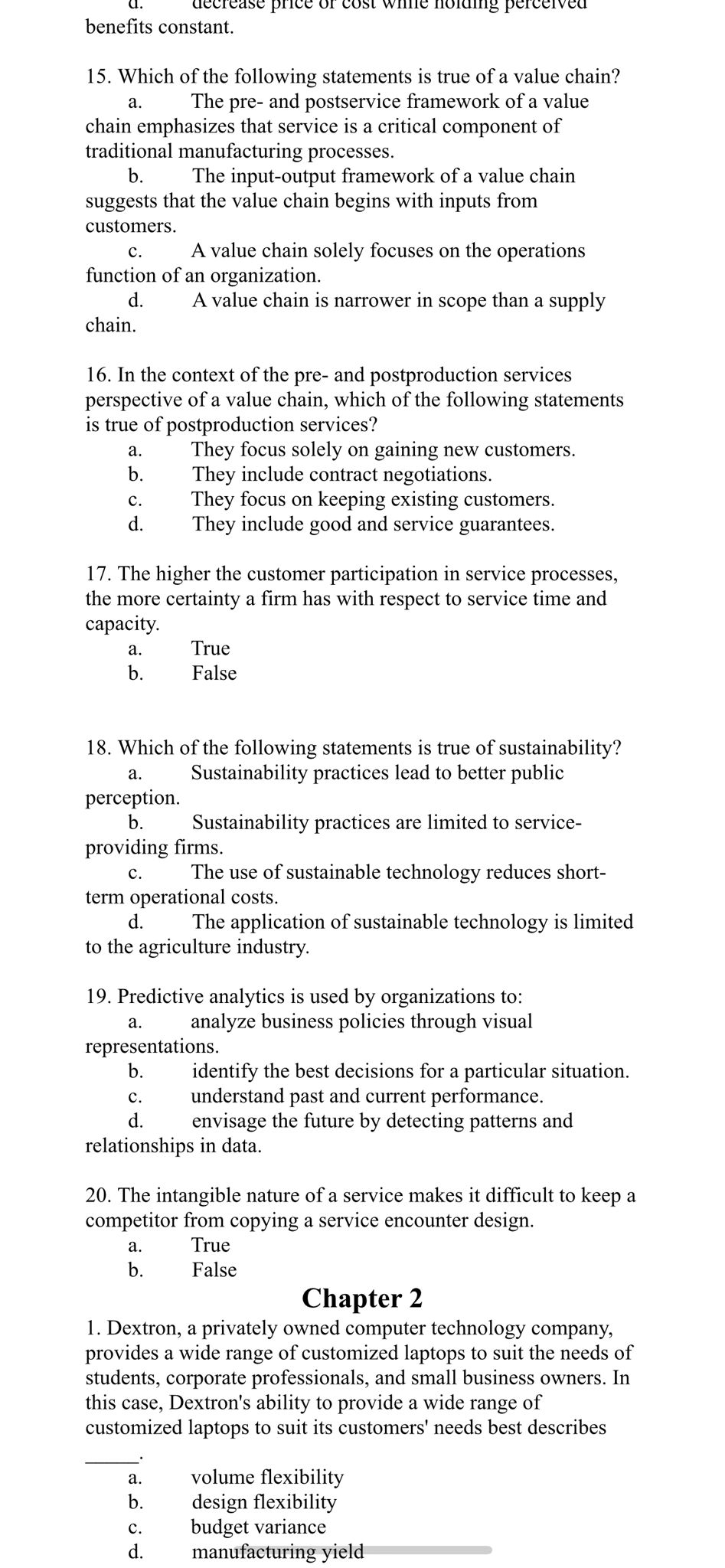 1. Which of the following is a similarity between goods and services? a. Both can be standardized for the mass market or customized to individual needs. b. Both use physical inventory as a buffer for fluctuations in demand. c. Both require customers to participate extensively in the creation and delivery processes. d. Both can be protected by patents owing to their tangible nature. 2. Jason and his friend went to a coffee shop. They ordered two cappuccinos and received a complimentary chocolate waffle and cookie along with their order. In the context of a customer benefit package (CBP), the chocolate waffle and the cookie are a. intangible products b. core offerings c. peripheral goods d. primary goods 3. North Zone Bank gives all its customers a complimentary credit card along with a custom-made wallet when they open an account with the bank. The credit card and the wallet are examples of offered by the bank. a. peripheral goods b. core offerings c. intangible products d. primary goods 4. Which of the following is an example of a primary service? a. The cooling provided by an air conditioner b. The customer service hotline of an electronics company c. A pen drive given along with a laptop d. An antivirus program given along with a smartphone 5. Jane is planning to go on a camping trip. She purchases a bottle of mineral water, a pack of biscuits, a small tube of toothpaste, and a toothbrush from the supermarket near her house. The items that Jane has purchased from the supermarket are goods. a. hard b. durable c. nondurable d. intangible 6. Identify a difference between goods and services. a. Goods can be stored as physical inventory, whereas services cannot be stored as physical inventory. b. Goods-producing firms rely solely on soft technology, whereas service-providing firms rely solely on hard technology. c. The demand for goods cannot be predicted, whereas the demand for services can be easily predicted. d. Customers directly participate in goods-producing activities, whereas customers do not participate in service- benefits constant. 15. Which of the following statements is true of a value chain? a. The pre- and postservice framework of a value chain emphasizes that service is a critical component of traditional manufacturing processes. b. The input-output framework of a value chain suggests that the value chain begins with inputs from customers. c. A value chain solely focuses on the operations function of an organization. d. A value chain is narrower in scope than a supply chain. 16. In the context of the pre- and postproduction services perspective of a value chain, which of the following statements is true of postproduction services? a. They focus solely on gaining new customers. b. They include contract negotiations. c. They focus on keeping existing customers. d. They include good and service guarantees. 17. The higher the customer participation in service processes, the more certainty a firm has with respect to service time and capacity. a. True b. False 18. Which of the following statements is true of sustainability? a. Sustainability practices lead to better public perception. b. Sustainability practices are limited to serviceproviding firms. c. The use of sustainable technology reduces shortterm operational costs. d. The application of sustainable technology is limited to the agriculture industry. 19. Predictive analytics is used by organizations to: a. analyze business policies through visual representations. b. identify the best decisions for a particular situation. c. understand past and current performance. d. envisage the future by detecting patterns and relationships in data. 20. The intangible nature of a service makes it difficult to keep a competitor from copying a service encounter design. a. True b. False Chapter 2 1. Dextron, a privately owned computer technology company, provides a wide range of customized laptops to suit the needs of students, corporate professionals, and small business owners. In this case, Dextron's ability to provide a wide range of customized laptops to suit its customers' needs best describes a. volume flexibility b. design flexibility c. budget variance d. manufacturing yield the demand for services can be easily predicted. d. Customers directly participate in goods-producing activities, whereas customers do not participate in serviceproviding activities. 7. Which of the following statements is true of goods? a. Goods-producing industries rely on machines and hard technology to perform work. b. Goods-producing employees require stronger behavioral skills than physical skills. c. The demand for goods is more difficult to predict than the demand for services. d. Durable goods are those that are no longer useful once they are used. 8. In the context of the pre- and postproduction services perspective of a value chain, which of the following statements is true of preproduction services? a. They focus on gaining a customer. b. They include on-site installation and application services. c. They focus solely on keeping an existing customer. d. They include recycling and remanufacturing initiatives. 9. Which of the following statements is true of service employees? a. They require good human interaction skills and strong cross-selling skills. b. They perform mechanized and rigid processes. c. They have little or no interaction with customers. d. They rely more on hard technology than soft technology to perform work. 10. Service encounter design is a key activity performed by operations managers that involves: a. managing the flow of materials, information, people, and money from suppliers to customers. b. ensuring that the right amount of resources is available when needed. c. predicting the future demand for raw materials, finished goods, and services. d. determining how to recover from service upsets. 11. Which of the following statements is true of operations management (OM) ? a. The application of the concepts and methods of OM is limited to the technology industry. b. OM is the only function by which managers can directly affect the value provided to all stakeholders. c. The activities involved in OM focus on creating value solely for external customers. d. OM and its principles are exclusively applicable to firms that produce tangible products. 12. Which of the following statements is true of goodsproducing processes? a. They use employees as a substitute for physical inventory. b. They require extensive customer participation in service creation and delivery. d. determining how to recover from service upsets. 11. Which of the following statements is true of operations management (OM) ? a. The application of the concepts and methods of OM is limited to the technology industry. b. OM is the only function by which managers can directly affect the value provided to all stakeholders. c. The activities involved in OM focus on creating value solely for external customers. d. OM and its principles are exclusively applicable to firms that produce tangible products. 12. Which of the following statements is true of goodsproducing processes? a. They use employees as a substitute for physical inventory. b. They require extensive customer participation in service creation and delivery. c. They require more flexibility and adaptation to special circumstances than service processes. d. They are mechanistic and controllable because of the lack of customer participation. 13. Which of the following statements is true of service facilities? a. They need to be in close proximity to customers. b. They store their services as physical inventory. c. They require employees with stronger technical skills than behavioral skills. d. They rely more on hard technology than soft technology to perform work. 14. In order to increase value, an organization must: a. increase perceived benefits while decreasing actual benefits. b. increase both perceived benefits and price or cost proportionally. c. decrease both perceived benefits and price or cost proportionally. d. decrease price or cost while holding perceived benefits constant. 15. Which of the following statements is true of a value chain? a. The pre- and postservice framework of a value chain emphasizes that service is a critical component of traditional manufacturing processes. b. The input-output framework of a value chain suggests that the value chain begins with inputs from customers. c. A value chain solely focuses on the operations function of an organization. d. A value chain is narrower in scope than a supply chain. 16. In the context of the pre- and postproduction services perspective of a value chain, which of the following statements is true of postproduction services? a. They focus solely on gaining new customers. b. They include contract negotiations. c. They focus on keeping existing customers. d. They include good and service guarantees
1. Which of the following is a similarity between goods and services? a. Both can be standardized for the mass market or customized to individual needs. b. Both use physical inventory as a buffer for fluctuations in demand. c. Both require customers to participate extensively in the creation and delivery processes. d. Both can be protected by patents owing to their tangible nature. 2. Jason and his friend went to a coffee shop. They ordered two cappuccinos and received a complimentary chocolate waffle and cookie along with their order. In the context of a customer benefit package (CBP), the chocolate waffle and the cookie are a. intangible products b. core offerings c. peripheral goods d. primary goods 3. North Zone Bank gives all its customers a complimentary credit card along with a custom-made wallet when they open an account with the bank. The credit card and the wallet are examples of offered by the bank. a. peripheral goods b. core offerings c. intangible products d. primary goods 4. Which of the following is an example of a primary service? a. The cooling provided by an air conditioner b. The customer service hotline of an electronics company c. A pen drive given along with a laptop d. An antivirus program given along with a smartphone 5. Jane is planning to go on a camping trip. She purchases a bottle of mineral water, a pack of biscuits, a small tube of toothpaste, and a toothbrush from the supermarket near her house. The items that Jane has purchased from the supermarket are goods. a. hard b. durable c. nondurable d. intangible 6. Identify a difference between goods and services. a. Goods can be stored as physical inventory, whereas services cannot be stored as physical inventory. b. Goods-producing firms rely solely on soft technology, whereas service-providing firms rely solely on hard technology. c. The demand for goods cannot be predicted, whereas the demand for services can be easily predicted. d. Customers directly participate in goods-producing activities, whereas customers do not participate in service- benefits constant. 15. Which of the following statements is true of a value chain? a. The pre- and postservice framework of a value chain emphasizes that service is a critical component of traditional manufacturing processes. b. The input-output framework of a value chain suggests that the value chain begins with inputs from customers. c. A value chain solely focuses on the operations function of an organization. d. A value chain is narrower in scope than a supply chain. 16. In the context of the pre- and postproduction services perspective of a value chain, which of the following statements is true of postproduction services? a. They focus solely on gaining new customers. b. They include contract negotiations. c. They focus on keeping existing customers. d. They include good and service guarantees. 17. The higher the customer participation in service processes, the more certainty a firm has with respect to service time and capacity. a. True b. False 18. Which of the following statements is true of sustainability? a. Sustainability practices lead to better public perception. b. Sustainability practices are limited to serviceproviding firms. c. The use of sustainable technology reduces shortterm operational costs. d. The application of sustainable technology is limited to the agriculture industry. 19. Predictive analytics is used by organizations to: a. analyze business policies through visual representations. b. identify the best decisions for a particular situation. c. understand past and current performance. d. envisage the future by detecting patterns and relationships in data. 20. The intangible nature of a service makes it difficult to keep a competitor from copying a service encounter design. a. True b. False Chapter 2 1. Dextron, a privately owned computer technology company, provides a wide range of customized laptops to suit the needs of students, corporate professionals, and small business owners. In this case, Dextron's ability to provide a wide range of customized laptops to suit its customers' needs best describes a. volume flexibility b. design flexibility c. budget variance d. manufacturing yield the demand for services can be easily predicted. d. Customers directly participate in goods-producing activities, whereas customers do not participate in serviceproviding activities. 7. Which of the following statements is true of goods? a. Goods-producing industries rely on machines and hard technology to perform work. b. Goods-producing employees require stronger behavioral skills than physical skills. c. The demand for goods is more difficult to predict than the demand for services. d. Durable goods are those that are no longer useful once they are used. 8. In the context of the pre- and postproduction services perspective of a value chain, which of the following statements is true of preproduction services? a. They focus on gaining a customer. b. They include on-site installation and application services. c. They focus solely on keeping an existing customer. d. They include recycling and remanufacturing initiatives. 9. Which of the following statements is true of service employees? a. They require good human interaction skills and strong cross-selling skills. b. They perform mechanized and rigid processes. c. They have little or no interaction with customers. d. They rely more on hard technology than soft technology to perform work. 10. Service encounter design is a key activity performed by operations managers that involves: a. managing the flow of materials, information, people, and money from suppliers to customers. b. ensuring that the right amount of resources is available when needed. c. predicting the future demand for raw materials, finished goods, and services. d. determining how to recover from service upsets. 11. Which of the following statements is true of operations management (OM) ? a. The application of the concepts and methods of OM is limited to the technology industry. b. OM is the only function by which managers can directly affect the value provided to all stakeholders. c. The activities involved in OM focus on creating value solely for external customers. d. OM and its principles are exclusively applicable to firms that produce tangible products. 12. Which of the following statements is true of goodsproducing processes? a. They use employees as a substitute for physical inventory. b. They require extensive customer participation in service creation and delivery. d. determining how to recover from service upsets. 11. Which of the following statements is true of operations management (OM) ? a. The application of the concepts and methods of OM is limited to the technology industry. b. OM is the only function by which managers can directly affect the value provided to all stakeholders. c. The activities involved in OM focus on creating value solely for external customers. d. OM and its principles are exclusively applicable to firms that produce tangible products. 12. Which of the following statements is true of goodsproducing processes? a. They use employees as a substitute for physical inventory. b. They require extensive customer participation in service creation and delivery. c. They require more flexibility and adaptation to special circumstances than service processes. d. They are mechanistic and controllable because of the lack of customer participation. 13. Which of the following statements is true of service facilities? a. They need to be in close proximity to customers. b. They store their services as physical inventory. c. They require employees with stronger technical skills than behavioral skills. d. They rely more on hard technology than soft technology to perform work. 14. In order to increase value, an organization must: a. increase perceived benefits while decreasing actual benefits. b. increase both perceived benefits and price or cost proportionally. c. decrease both perceived benefits and price or cost proportionally. d. decrease price or cost while holding perceived benefits constant. 15. Which of the following statements is true of a value chain? a. The pre- and postservice framework of a value chain emphasizes that service is a critical component of traditional manufacturing processes. b. The input-output framework of a value chain suggests that the value chain begins with inputs from customers. c. A value chain solely focuses on the operations function of an organization. d. A value chain is narrower in scope than a supply chain. 16. In the context of the pre- and postproduction services perspective of a value chain, which of the following statements is true of postproduction services? a. They focus solely on gaining new customers. b. They include contract negotiations. c. They focus on keeping existing customers. d. They include good and service guarantees Step by Step Solution
There are 3 Steps involved in it
Step: 1

Get Instant Access to Expert-Tailored Solutions
See step-by-step solutions with expert insights and AI powered tools for academic success
Step: 2

Step: 3

Ace Your Homework with AI
Get the answers you need in no time with our AI-driven, step-by-step assistance
Get Started


